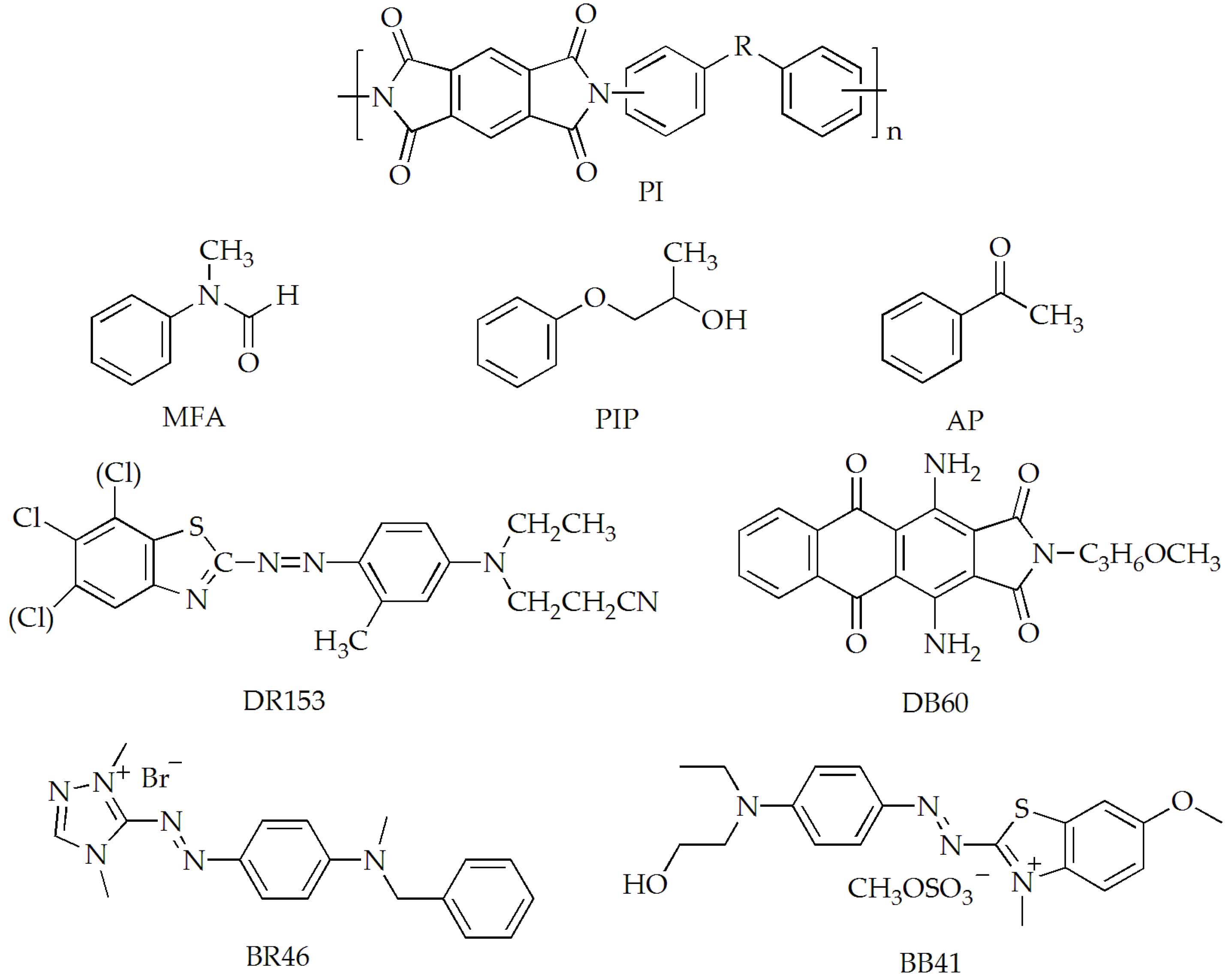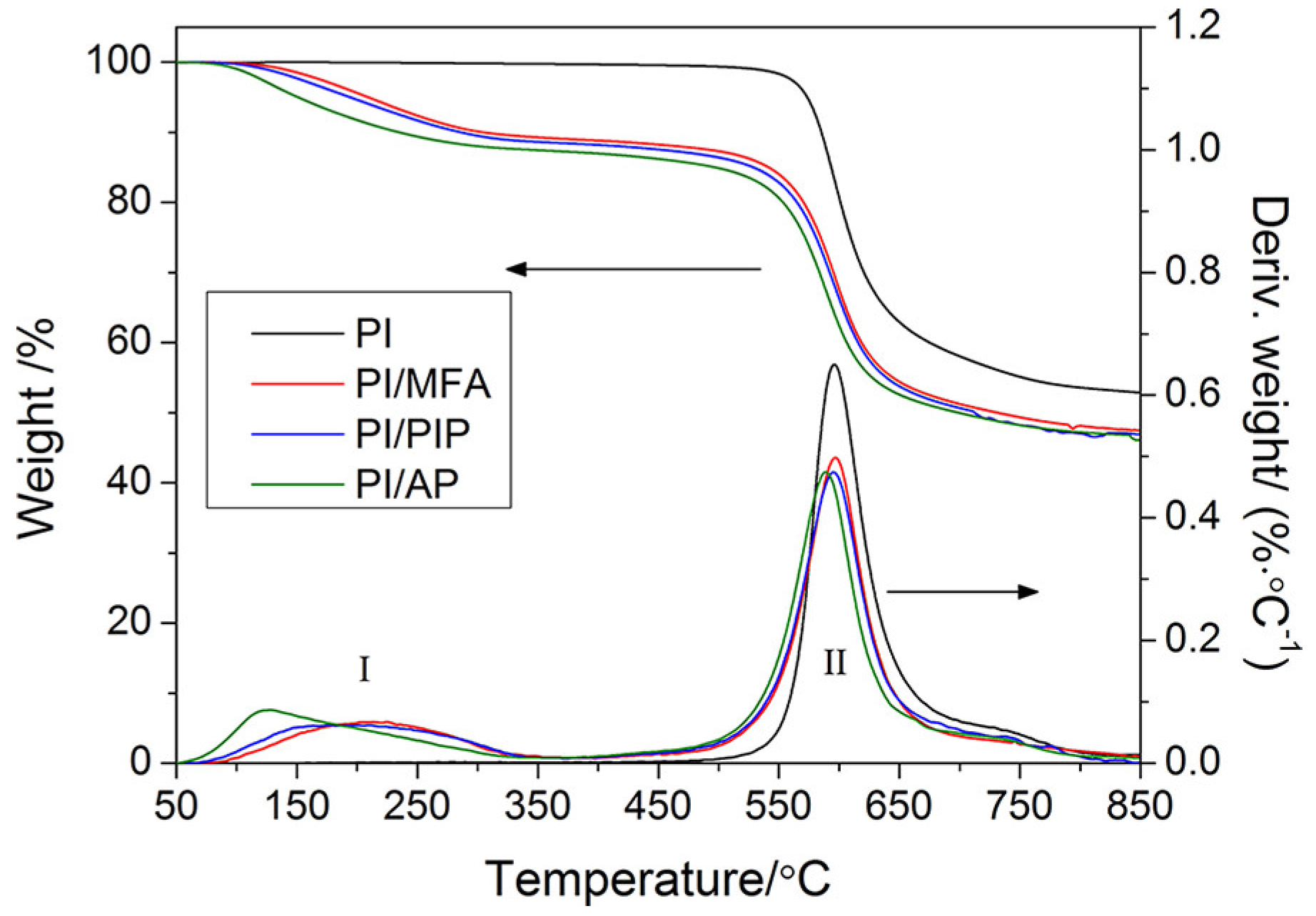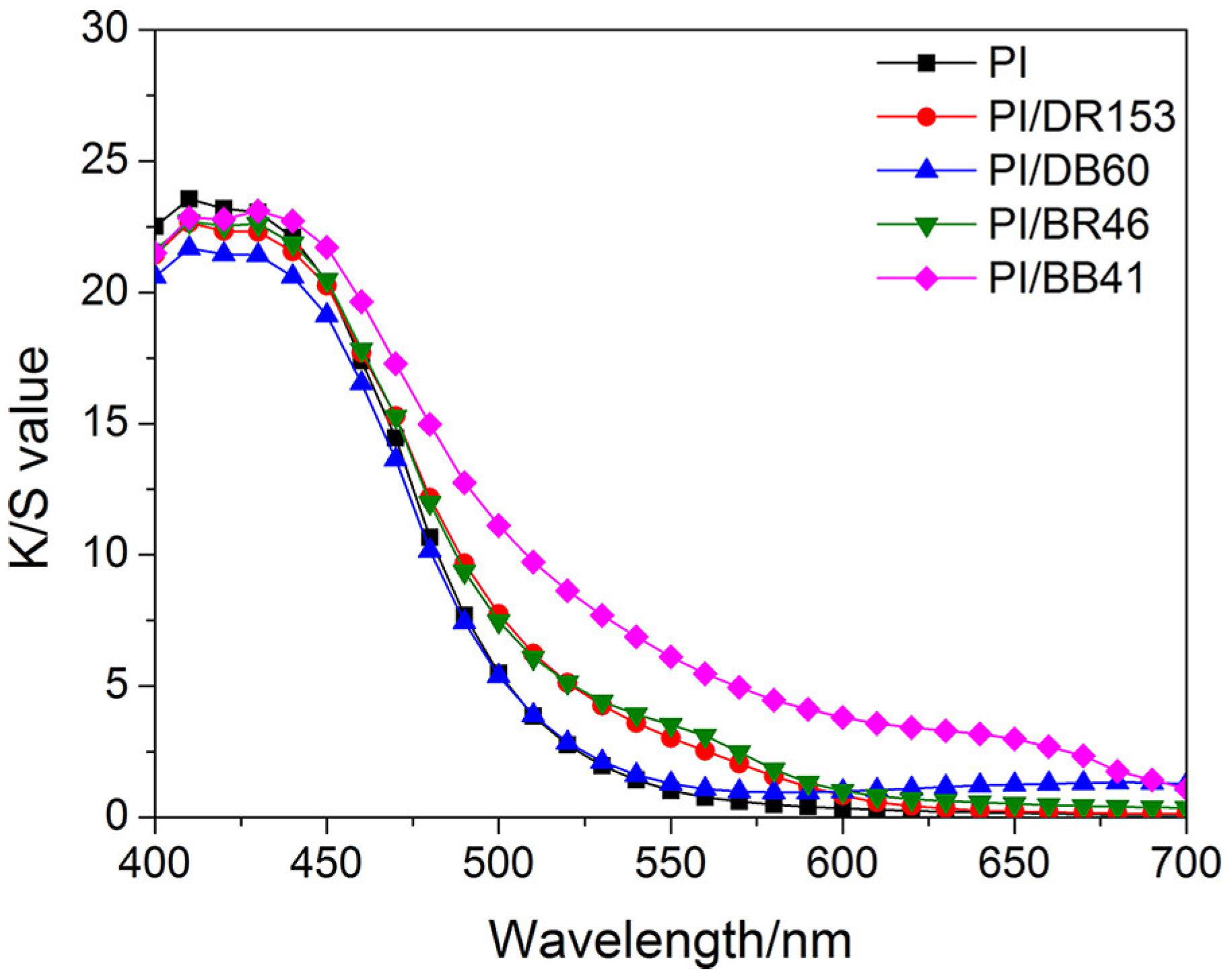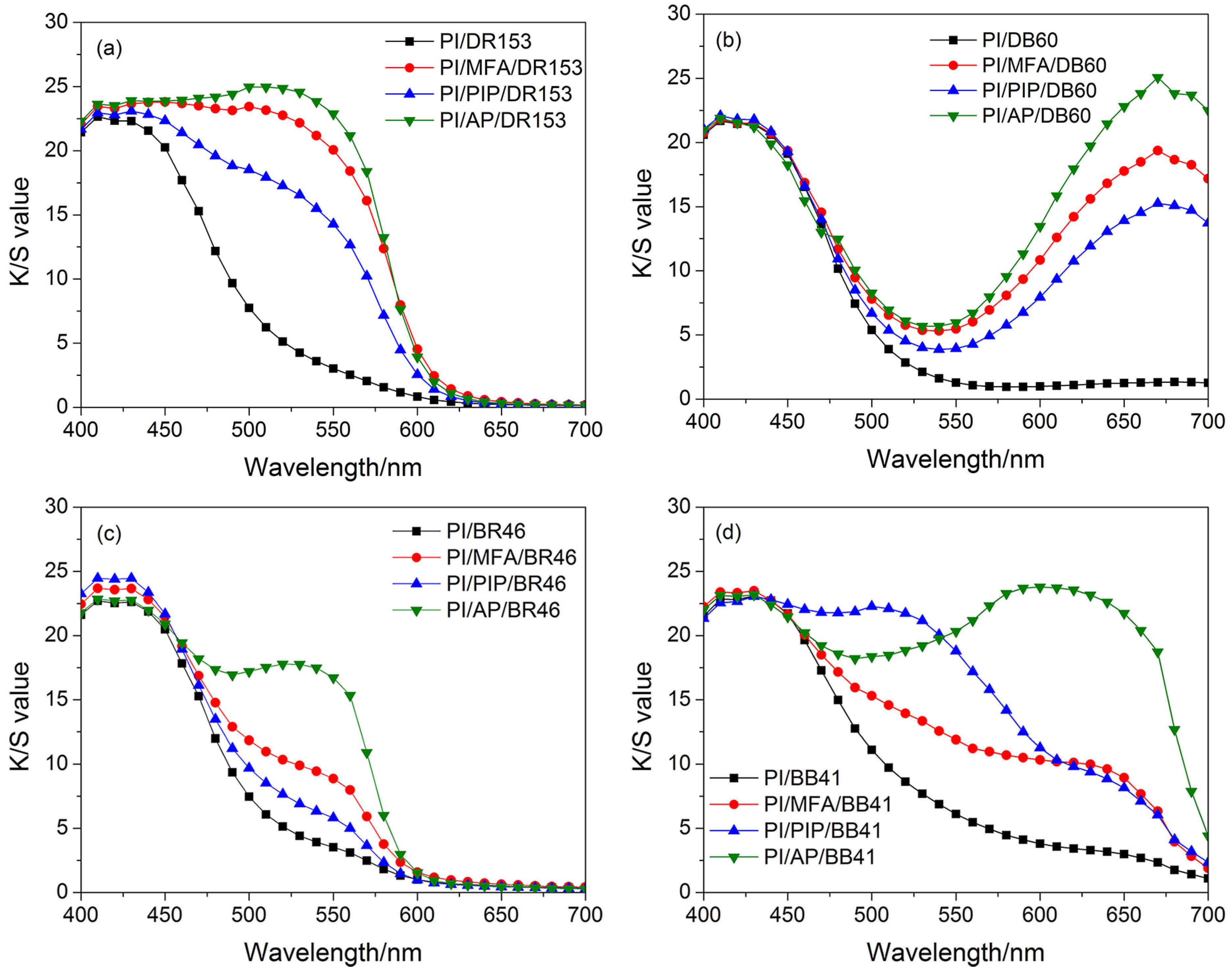Enhancing the Dyeability of Polyimide Fibers with the Assistance of Swelling Agents
Abstract
:1. Introduction
2. Materials and Methods
2.1. Materials
2.2. Dyeing of PI Fibers
2.3. Testing of PI Fibers
2.3.1. Thermal Analysis
2.3.2. Surface Morphology
2.3.3. Tensile Properties
2.3.4. Crystalline Analysis
2.3.5. Color Strength
2.3.6. Colorfastness to Washing of the Dyed PI Fibers
3. Results and Discussion
3.1. Effect of Swelling Agents on PI Fibers
3.2. Effect of Swelling Agents on the Dyeability of PI Fibers
4. Conclusions
Author Contributions
Funding
Conflicts of Interest
References
- Liaw, D.J.; Wang, K.L.; Huang, Y.C.; Lee, K.R.; Lai, J.Y.; Ha, C.S. Advanced polyimide materials: Syntheses, physical properties and applications. Prog. Polym. Sci. 2012, 37, 907–974. [Google Scholar] [CrossRef]
- Kotek, R. Recent Advances in Polymer Fibers. Polym. Rev. 2008, 48, 221–229. [Google Scholar] [CrossRef]
- Zhang, M.Y.; Niu, H.Q.; Wu, D.Z. Polyimide Fibers with High Strength and High Modulus: Preparation, Structures, Properties, and Applications. Macromol. Rapid Commun. 2018, 39, 1800141. [Google Scholar] [CrossRef] [PubMed]
- Clausi, D.T.; Koros, W.J. Formation of defect-free polyimide hollow fiber membranes for gas separations. J. Membr. Sci. 2000, 167, 79–89. [Google Scholar] [CrossRef]
- Heo, C.; Chang, J.H. Polyimide nanocomposites based on functionalized graphene sheets: Morphologies, thermal properties, and electrical and thermal conductivities. Solid State Sci. 2013, 24, 6–14. [Google Scholar] [CrossRef]
- Karataş, S.; Kayaman-Apohan, N.; Demirer, H.; Güngör, A. Polyimide–silica hybrid coatings: Morphological, mechanical, and thermal investigations. Polym. Adv. Technol. 2007, 18, 490–496. [Google Scholar] [CrossRef]
- Vanherck, K.; Koeckelberghs, G.; Vankelecom, I.F.J. Crosslinking polyimides for membrane applications: A review. Prog. Polym. Sci. 2013, 38, 874–896. [Google Scholar] [CrossRef]
- Dong, J.; Yin, C.Q.; Zhao, X.; Li, Y.Z.; Zhang, Q.H. High strength polyimide fibers with functionalized graphene. Polymer 2013, 54, 6415–6424. [Google Scholar] [CrossRef]
- Qu, C.Z.; Hu, J.S.; Liu, X.; Li, Z. Morphology and Mechanical Properties of Polyimide Films: The Effects of UV Irradiation on Microscale Surface. Materials 2017, 10, 1329. [Google Scholar] [CrossRef]
- Kaneda, T.; Katsura, T.; Nakagawa, K.; Makino, H.; Horio, M. High-strength-high-modulus polyimide fibers II. Spinning and properties of fibers. J. Appl. Polym. Sci. 1986, 32, 3151–3176. [Google Scholar] [CrossRef]
- Xu, Y.; Wang, S.H.; Li, Z.T.; Xu, Q.; Zhang, Q.H. Polyimide fibers prepared by dry-spinning process: Imidization degree and mechanical properties. J. Mater. Sci. 2013, 48, 7863–7868. [Google Scholar] [CrossRef]
- Wang, S.H.; Dong, J.; Li, Z.T.; Xu, Y.; Tan, W.J.; Zhao, X.; Zhang, Q.H. Polyimide fibers prepared by a dry-spinning process: Enhanced mechanical properties of fibers containing biphenyl units. J. Appl. Polym. Sci. 2016, 133, 43727. [Google Scholar] [CrossRef]
- Bourbigot, S.; Flambard, X. Heat resistance and flammability of high performance fibres: A review. Fire Mater. 2002, 26, 155–168. [Google Scholar] [CrossRef]
- Morgan, A.B.; Putthanarat, S. Use of inorganic materials to enhance thermal stability and flammability behavior of a polyimide. Polym. Degrad. Stab. 2011, 96, 23–32. [Google Scholar] [CrossRef]
- Wang, Z.H.; Rao, Z.J.; Zhan, Y.Z.; Hao, T.Q.; Wang, W.; Yu, D. Improving the dyeability of polyimide by pretreatment with alkali. Color. Technol. 2016, 132, 481–487. [Google Scholar] [CrossRef]
- Bai, G.; Liu, Y.C.; Qian, H.F. Surface characteristics and dyeing properties of polyimide fabric treated with sodium hydroxide. Color. Technol. 2018, 135, 53–59. [Google Scholar] [CrossRef]
- Cao, G.Y.; Sheng, D.; Xu, W.L.; Wang, X. Structural and dyeing properties of aramid treated with 2-phenoxyethanol. Color. Technol. 2015, 131, 384–388. [Google Scholar] [CrossRef]
- Islam, M.T.; Aimone, F.; Ferri, A.; Rovero, G. Use of N-methylformanilide as swelling agent for meta-aramid fibers dyeing: Kinetics and equilibrium adsorption of Basic Blue 41. Dyes Pigm. 2015, 113, 554–561. [Google Scholar] [CrossRef]
- Kinashi, K.; Suzuki, T.; Yasunaga, H.; Tsuchida, H.; Sakai, W.; Tsutsumi, N.; Yamane, H. Carrier-assisted dyeing of poly (L-lactic acid) fibers with dispersed photochromic spiropyran dyes. Dyes Pigm. 2017, 145, 444–450. [Google Scholar] [CrossRef]
- Kim, I.S.; Cho, H.M.; Koh, J.; Kim, J.P. Low-temperature carrier dyeing of poly(vinyl chloride) fibers with disperse dyes. J. Appl. Polym. Sci. 2003, 90, 3896–3904. [Google Scholar] [CrossRef]
- Kulshreshtha, A.K.; Khan, A.H.; Madan, G.L. X-ray diffraction study of solvent-induced crystallization in polyester filaments. Polymer 1978, 19, 819–823. [Google Scholar] [CrossRef]
- Chidambaram, D.; Venkatraj, R.; Manisankar, P. Solvent-induced modifications in polyester yarns. II. Structural and thermal behavior. J. Appl. Polym. Sci. 2003, 89, 1555–1566. [Google Scholar] [CrossRef]






| Sample | Temperature of Maximum Degradation Rate (°C) | Weight Loss at 350 °C (%) | |
|---|---|---|---|
| I | II | ||
| Polyimide (PI) | None | 595.9 | 0.24 |
| PI/N-methylformanilide (MFA) | 213.1 | 596.9 | 10.72 |
| PI/Phenoxyisopropanol (PIP) | 209.6 | 595.2 | 11.36 |
| PI/Acetophenone (AP) | 128.3 | 588.8 | 12.55 |
| Yarn | Breaking Strength (cN/tex) | Breaking Elongation (%) |
|---|---|---|
| PI | 25.32 | 9.78 |
| PI/MFA | 20.53 | 8.04 |
| PI/PIP | 20.43 | 7.84 |
| PI/AP | 21.16 | 9.41 |
| Dye | Swelling Agents | Color Change | Color Stain | |||||
|---|---|---|---|---|---|---|---|---|
| Wool | Acrylic | Polyester | Polyamide | Cotton | Acetate | |||
| DR 153 | MFA | 4–5 | 3 | 4–5 | 3–4 | 3 | 4 | 3 |
| PIP | 4–5 | 3 | 3–4 | 2–3 | 2 | 3 | 2–3 | |
| AP | 4–5 | 3–4 | 4 | 3 | 2–3 | 3–4 | 3 | |
| DB 60 | MFA | 5 | 5 | 5 | 5 | 5 | 5 | 5 |
| PIP | 5 | 5 | 5 | 5 | 5 | 5 | 5 | |
| AP | 5 | 5 | 5 | 5 | 4 | 5 | 5 | |
| BR 46 | MFA | 5 | 5 | 5 | 5 | 5 | 3–4 | 5 |
| PIP | 5 | 4–5 | 5 | 5 | 4–5 | 3 | 4–5 | |
| AP | 4–5 | 4 | 4–5 | 4 | 4–5 | 3 | 4–5 | |
| BB 41 | MFA | 5 | 5 | 5 | 5 | 4 | 5 | 4–5 |
| PIP | 4–5 | 4 | 5 | 4 | 3 | 3 | 3 | |
| AP | 5 | 4–5 | 5 | 4–5 | 3–4 | 3 | 3–4 | |
© 2019 by the authors. Licensee MDPI, Basel, Switzerland. This article is an open access article distributed under the terms and conditions of the Creative Commons Attribution (CC BY) license (http://creativecommons.org/licenses/by/4.0/).
Share and Cite
Shao, D.; Xu, C.; Wang, H.; Du, J. Enhancing the Dyeability of Polyimide Fibers with the Assistance of Swelling Agents. Materials 2019, 12, 347. https://doi.org/10.3390/ma12030347
Shao D, Xu C, Wang H, Du J. Enhancing the Dyeability of Polyimide Fibers with the Assistance of Swelling Agents. Materials. 2019; 12(3):347. https://doi.org/10.3390/ma12030347
Chicago/Turabian StyleShao, Dongyan, Changhai Xu, Hongbo Wang, and Jinmei Du. 2019. "Enhancing the Dyeability of Polyimide Fibers with the Assistance of Swelling Agents" Materials 12, no. 3: 347. https://doi.org/10.3390/ma12030347




